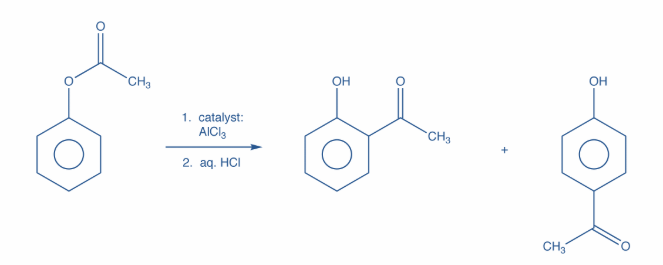
Which products are obtained when phenyl ethanoate reacts in presence of Anh $AlC{l_3}$ ?
A.$\sigma $ -Ethoxy acetophenone and p-Ethoxy acetophenone.
B.O-Hydroxy acetophenone and p-Hydroxy acetophenone
C.$\sigma $ -Methyl acetophenone and p-Methyl acetophenone
D.$\sigma $ Methoxy acetophenone and p-Methoxy acetophenone.
Answer
138.6k+ views
Hint: Phenyl ethanoate is basically the ester of phenol and acetic acid. It can further be produced by decarboxylation of aspirin or by reacting phenol with acetyl chloride or acetic anhydride. Moreover, aluminium chloride is used as a Lewis acid catalyst for a variety of reactions.
Complete step by step answer:
Ester is basically a chemical compound that is derived from an organic or inorganic acid in which hydroxyl group is replaced by an alkyl group. Moreover, esters are a group of chemical compounds which are formed by bonding of an alcohol group with a group of organic acids by losing water molecules.
Now, the products obtained when phenyl ethanoate reacts in presence of Anh. $AlC{l_3}$are o-hydroxy acetophenone and p-hyroxy acetophenone. This is known as Fries Rearrangement. Further, it is an organic rearrangement reaction in which an aryl ester is transformed into a hydroxyl aryl ketone with the help of a Lewis acid catalyst and an aqueous acid.
Moreover, this rearrangement is ortho and para selective i.e. the acyl group attaches itself at the ortho or para positions of the aryl ring. The reaction is as shown:

Hence, option B is correct.
Note: There are few limitations of this reaction. Owing to its relatively harsh reaction conditions, only esters with relatively stable acyl components can be used in this reaction. Moreover, the presence of deactivating or meta-directing groups on the aromatic ring results in low yields.
Complete step by step answer:
Ester is basically a chemical compound that is derived from an organic or inorganic acid in which hydroxyl group is replaced by an alkyl group. Moreover, esters are a group of chemical compounds which are formed by bonding of an alcohol group with a group of organic acids by losing water molecules.
Now, the products obtained when phenyl ethanoate reacts in presence of Anh. $AlC{l_3}$are o-hydroxy acetophenone and p-hyroxy acetophenone. This is known as Fries Rearrangement. Further, it is an organic rearrangement reaction in which an aryl ester is transformed into a hydroxyl aryl ketone with the help of a Lewis acid catalyst and an aqueous acid.
Moreover, this rearrangement is ortho and para selective i.e. the acyl group attaches itself at the ortho or para positions of the aryl ring. The reaction is as shown:

Hence, option B is correct.
Note: There are few limitations of this reaction. Owing to its relatively harsh reaction conditions, only esters with relatively stable acyl components can be used in this reaction. Moreover, the presence of deactivating or meta-directing groups on the aromatic ring results in low yields.
Recently Updated Pages
How to find Oxidation Number - Important Concepts for JEE

How Electromagnetic Waves are Formed - Important Concepts for JEE

Electrical Resistance - Important Concepts and Tips for JEE

Average Atomic Mass - Important Concepts and Tips for JEE

Chemical Equation - Important Concepts and Tips for JEE

Concept of CP and CV of Gas - Important Concepts and Tips for JEE

Trending doubts
JEE Main 2025 Session 2: Application Form (Out), Exam Dates (Released), Eligibility, & More

Electromagnetic radiation with maximum wavelength is class 11 chemistry JEE_Main

JEE Main 2025: Derivation of Equation of Trajectory in Physics

The correct order of electron affinity is A F Cl Br class 11 chemistry JEE_Main

Learn About Angle Of Deviation In Prism: JEE Main Physics 2025

Number of sigma and pi bonds in C2 molecule isare A class 11 chemistry JEE_Main

Other Pages
NCERT Solutions for Class 11 Chemistry Chapter 9 Hydrocarbons

NCERT Solutions for Class 11 Chemistry Chapter 7 Redox Reaction

JEE Advanced Marks vs Ranks 2025: Understanding Category-wise Qualifying Marks and Previous Year Cut-offs

NCERT Solutions for Class 11 Chemistry Chapter 5 Thermodynamics

Hydrocarbons Class 11 Notes: CBSE Chemistry Chapter 9

NCERT Solutions for Class 11 Chemistry In Hindi Chapter 1 Some Basic Concepts of Chemistry




